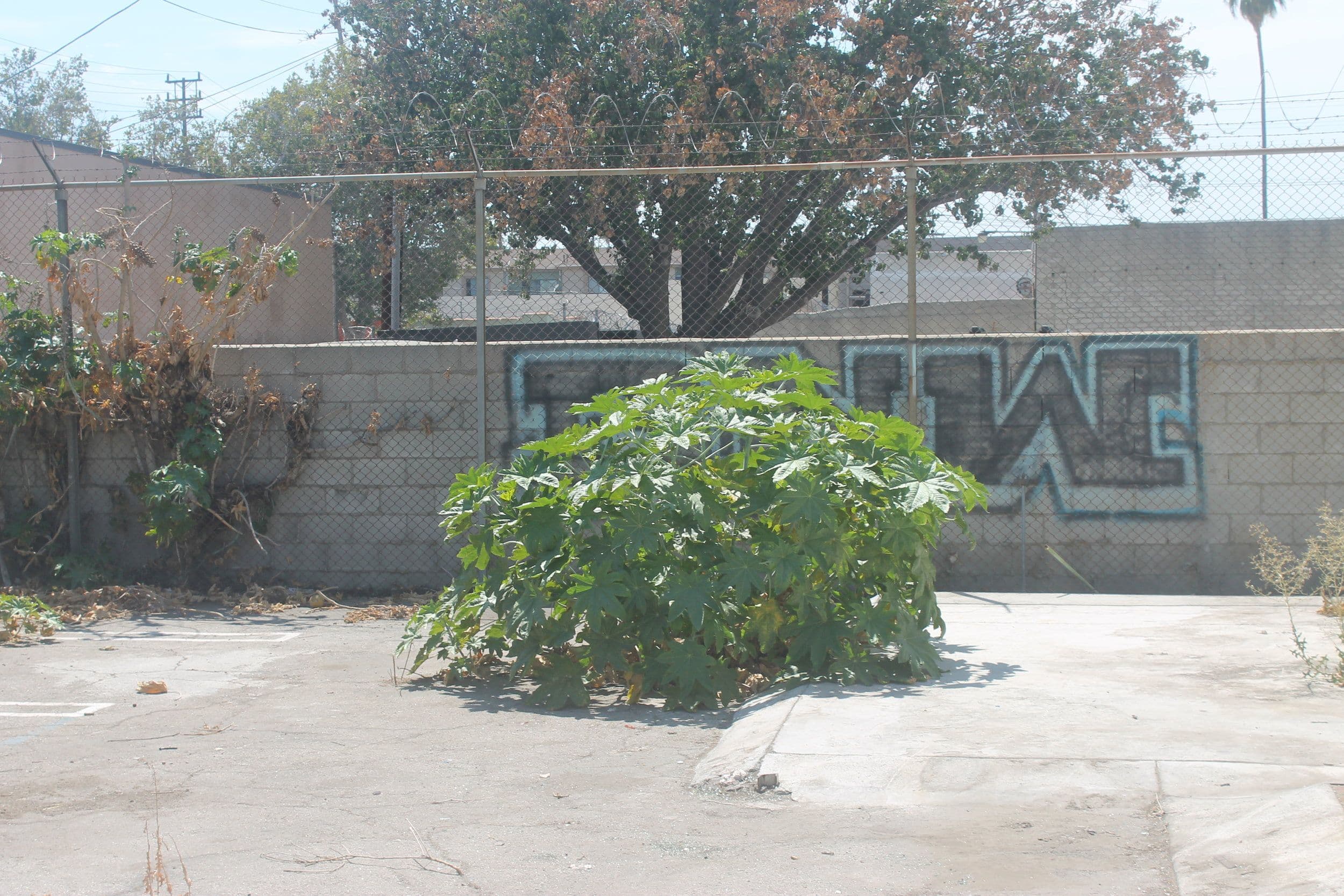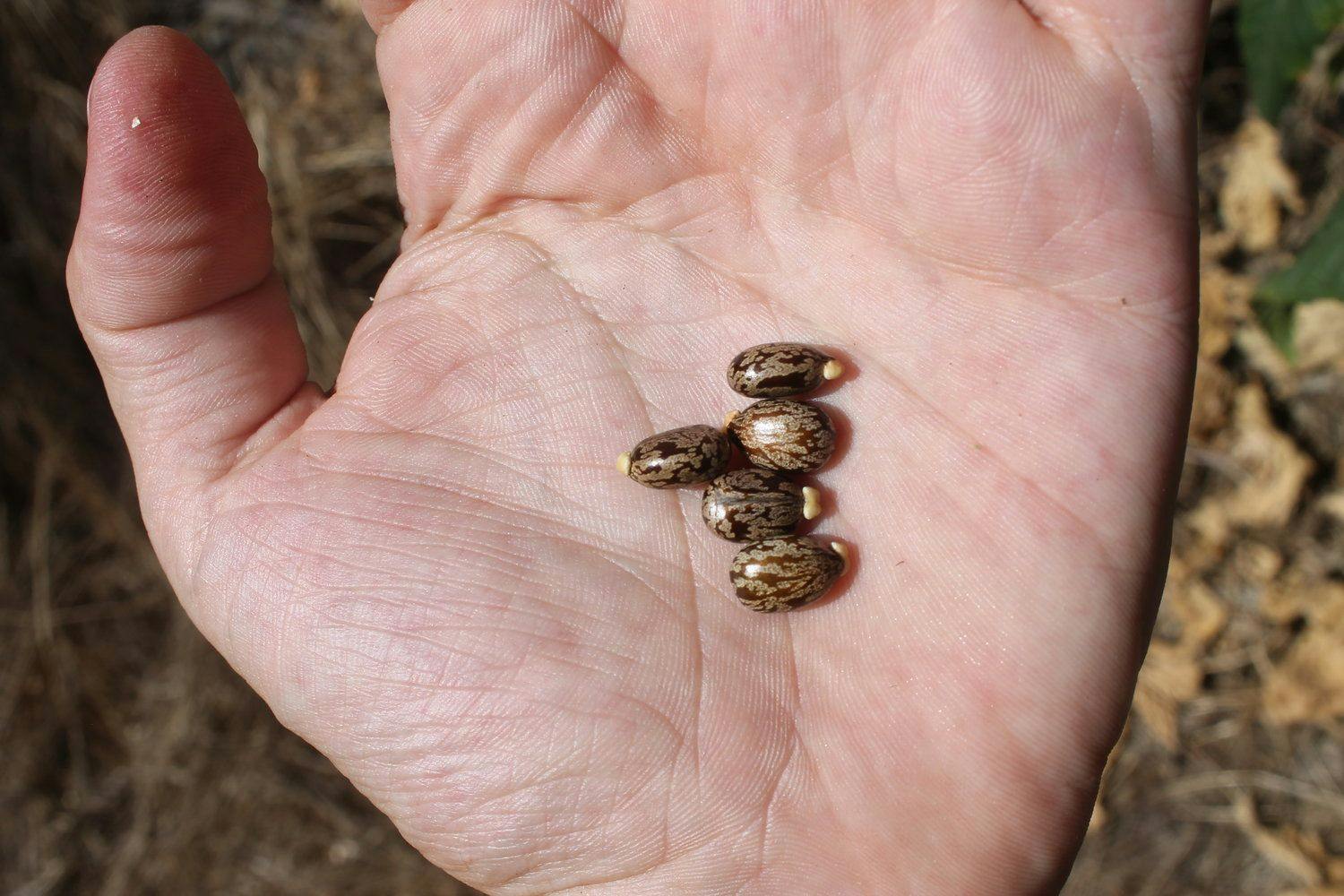The conversion of Los Angeles - an arid grass and shrubland rimmed by arid mountains - into the pseudotropical landscape of today was no small feat. It required the redistribution of enormous quantities of water and the introduction of a whole new set of plants. One early introduction was the Castor bean, a plant which would look more at home in an exotic jungle understory than in the full sun of Southern California. Though introduced to California primarily as a crop plant for the production of castor oil, nineteenth century Angelenos recognized its ornamental appeal and were so infatuated with its strange appearance and rapid growth that they sent specimens to Chicago to portray their city in the 1893 World’s Fair. Years later, the public became aware that the highly toxic seeds, the source of the poison ricin, could be consumed by unwitting children. This, coupled with concerns over its invasiveness, led to efforts to eradicate the plant. Eradicators must face their task humbly; the Castor bean escaped cultivation to colonize the developing landscape of LA at least 150 years ago, and is now well established. For better or worse, it has added a tropical look to the backwaters of Los Angeles since the city’s earliest days.


Castor bean is a striking, easily recognizable plant native to the Mediterranean Basin, East Africa and India. It can grow into a small tree, but is more often an erect shrub less than 10 feet tall. The palmate leaves range from six inches to well over a foot in length and contain five to twelve pointed lobes. Male and female flowers are borne separately along a flowering spike up to a foot in length. The yellow-green male flowers are found at the bottom of the spike, while the female flowers are located at the top of the flowering spike, inside the immature fruit capsule, from which feathery red stigmas protrude. Mature fruit capsules are spiny and have three chambers, each containing a smooth, mottled seed half an inch long. Each seed is adorned with a fleshy white appendage called an eliasome, which aids in its dispersal by ants. Castor bean is widely cultivated, and it has naturalized in anthropogenic landscapes throughout much of the tropical and subtropical world.
In Los Angeles, Castor bean proliferates in disturbed areas such as drainage ditches, roadsides, construction sites, back alleys and vacant lots. Given its large size, it is usually absent in manicured parts of the city, but is common in neglected areas. The extreme fecundity of Castor bean in Southern California has led to its designation as an invasive species. Though the California Invasive Plant Council rates it as only minimally invasive state-wide, the Los Angeles and San Gabriel River Watershed Council list it among the “Terrible Ten’ invasive plants of Southern California. Awareness of its invasiveness among the LA gardening public is high, and most nurseries in Southern California do not carry it. However, ornamental cultivars are popular and still available through mail order, particularly varieties which emphasize different leaf and fruit colors.


Pressing Castor bean seeds produces castor oil, a product with many uses. The most popular medical use of castor oil is as a powerful laxative. Its expulsory powers have made their way into pop culture; the famous pie eating scene from the 1986 film Stand by Me shows a character consuming a whole bottle of castor oil to induce vomiting. There is a darker side to these properties, their historical use as a punishment. A notable example took place in 1920s Italy, when the fascist Black Shirts would force feed castor oil to political dissidents as a form of humiliation (and presumably extreme discomfort). In addition to being a laxative, castor oil is touted for a variety of other health uses, including as a moisturizer, acne reducer and anti-inflammatory agent. The pharmaceutical industry uses it as an additive in a variety of drugs. It was even shown to stimulate labor in pregnant women who had previously had a child (though not those who were having their first). The unique chemistry of castor oil allows it to be broken down into its derivative compounds in a way that most other vegetable oils are not. For this reason, castor oil and its derivatives have a wide range of industrial applications, particularly as lubricants, hydraulic fluids and surfactants. In order to supply these industries, a massive quantity of Castor bean is cultivated. In India, well over a million tons of castor seeds are produced each year.
The extraction of castor oil removes ricin, a highly toxic protein, rendering the oil safe for human consumption. As little as a few milligrams of ricin can kill an adult, leading to a long and disturbing history of weaponized use. The United States and Soviet Union both studied its potential in warfare, experimenting with ways to coat bullets and shrapnel in ricin, or use bombs to spread its toxic dust over large areas. It has been implicated in a number of political assassinations, and was detected in letters sent to Michael Bloomberg and Barack Obama from a disgruntled former actress in 2013. The quantity of ricin in castor seeds is significant, but it appears that many must be ingested to be lethal. A woman who consumed 30 seeds in a suicide attempt did not die.

The history of the Castor bean in Los Angeles is surprisingly well documented in old newspaper articles. The earliest of these, from the second half of the nineteenth century, are all business. They exuberantly celebrate the prolific growth of Castor bean in California and its potential to produce more income per acre than other crops. But high tariffs on Indian imports were not enough to make California-grown seeds competitive on a large scale, so Castor bean fell out of favor. Towards the end of World War I, there was another spike of interest in Castor bean, this time fueled by the war effort and the use of castor oil in airplane engines. Many newspaper articles encouraged California farmers to do their patriotic duty to support the war effort by planting Castor bean. As technology pushed this application into obsolescence, Castor bean once again withdrew from the public eye. In the 1960s, the deadly nature of the seeds became a focus of newspaper editors, and a whole slew of articles were published about the hidden dangers lurking in gardens. More recent articles identify its invasiveness and describe eradication efforts in places such as the Sepulveda Basin.
The disturbance-loving habit of the Castor bean in Los Angeles was identified early, and as it proliferated in the rapidly developing landscape, it became a common backdrop to life in the rough and tumble city streets. In 1887, two laborers were arrested after being found “on Alameda street, under a Castor bean bush, [making] preparations to take hypodermic injections” of morphine sulfate. In 1895, a hired gunman hiding under a Castor bean plant attempted to assassinate a witness against a Chinese gangster. The following year, muggers escaped into a thicket of Castor bean bushes at the corner of Omar and Boyd with “some $60 in gold and greenbacks.” In 1901, a young man slipped on a Castor bean stalk at the corner of 5th and San Pedro, breaking his left kneecap. Though references to the Castor bean in relation to the darker sides of the city are sparser in recent years, there’s no doubt that they are a backdrop to all kinds of nefarious activity. Today, Castor bean is most abundant in the city’s roughest and least policed areas.

The average Angeleno probably does not look at the large-leaved and conspicuous plant growing wild throughout their city as an escaped crop with enormous industrial use, or as the source of one of the world's deadly poisons. To many, Castor bean is nothing but an unwanted weed, causing ecological havoc and tarnishing the Mediterranean look of the pre-European landscape. To others, it is simply part of the unseen backdrop of the city, and not thought about at all. To me, it is a perfect example of the malleable cultural value that we attach to everything around us. Over the course of its history in Los Angeles the Castor bean has been admired, valued and vilified. This tropical-leaved shrub of back alleys and construction sites is a poster child of an emergent anthropogenic nature where these contradictory values are common. A nature which can be described as wild, tame, ugly, and beautiful in the same breath.

